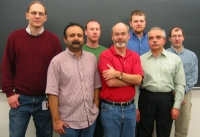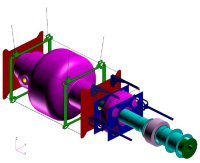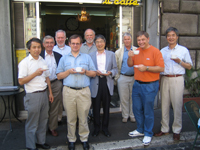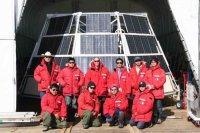 |
|
|
 |
University Profile: Northern Illinois University
More than a hundred universities around the globe are contributing to International Linear Collider R&D. Share your story with ILC NewsLine, and we will feature your university in an upcoming issue.

Members of the NICADD team at Northern Illinois University who contribute to ILC R&D are (left to right) Victor Rykalin, Vishnu Zutshi, John Powell, Gerald Blazey, Mike Smith, Alexandre Dychkant and Kurt Francis. (Image courtesy of NIU) |
Amidst the corn fields in DeKalb Illinois, 65 miles to the west of Chicago, a group of 22 physicists and students, who are members of the Northern Illinois Center for Accelerator and Detector Development (NICADD) at Northern Illinois University, contribute to the International Linear Collider in more ways than one. From beam dynamics to calorimetry hardware to simulation software, the ILC group at NIU covers it all. Because the group consists of such a large number of undergraduate and graduate students, training the future generation of scientists – who may be running the actual ILC one day – is perhaps one of their largest contributions of all.
Read more...
-- Elizabeth Clements |
 |
|
|
 |
|
 |
Crabbing in the cavity

A CAD drawing of a crab cavity |
What do superconducting cavities and the beach have in common? KEK accelerator physicists can give you the answer: the crab. During the spring operation period of the KEKB accelerator, scientists successfully achieved effective electron-positron collisions in a new cavity. Called the crab cavity, it tilts each bunch sideways so that the bunches collide head-on at the interaction point. This success will allow the KEKB to boost its luminosity, which is already the world’s highest for a B-factory, to an unprecedented level. Crab cavities will also play an important role in achieving high luminosities at other machines, including the International Linear Collider (ILC), upgrades for the Large Hadron Collider (LHC) at CERN, as well as future synchrotron light sources.
Read more...
-- Rika Takahashi |
 |
|
|
 |
|
When in Rome
 The GDE Executive Committee needed a lot of coffee duing the last few days. Senior management got together to make plans for the Engineering Design Report phase and to prepare for Wednesday's meeting of the Funding Agencies for Large Colliders (FALC), where they presented the final Reference Design Report in talks and even a printed copy to FALC members. But they were in luck: the meeting took place in Rome where there's plenty of excellent coffee.
The GDE Executive Committee needed a lot of coffee duing the last few days. Senior management got together to make plans for the Engineering Design Report phase and to prepare for Wednesday's meeting of the Funding Agencies for Large Colliders (FALC), where they presented the final Reference Design Report in talks and even a printed copy to FALC members. But they were in luck: the meeting took place in Rome where there's plenty of excellent coffee.
|
 |
|
|
 |
From Nature Magazine
11 July 2007
French universities to gain control
“In the race against Stanford, Cambridge or Harvard, French universities run with their laces tied together and a backpack full of stones.” So said Nicolas Sarkozy in the run-up to the French presidential election, as he pledged to reform the country's archaic university system.
Read more... |
|
From Nature Magazine
11 July 2007
Austria's science institute gathers steam
Austria will, after all, get the élite graduate-level institute it wants — even though plans seemed on the verge of collapse last year.
Read more... |
|
From FYI: AIP Bulletin of Science Policy News
9 July 2007
Senate Appropriators Recommend 10.8 Percent Increase for NSF in FY 2008
The Senate Appropriations Committee has sent to the floor an FY 2008 appropriations bill that would increase the National Science Foundation's budget by 10.8 percent.
Read more... |
|
From Stanford News Service
6 July 2007
SLAC names new director and deputy director of particle and particle astrophysics
Steven Kahn, deputy director of the Kavli Institute for Particle Astrophysics and Cosmology at Stanford University, has been named director of particle and particle astrophysics at the Stanford Linear Accelerator Center (SLAC).
Read more... |
|
|
 |
Akira Yamamoto: A man of calm and expressions
Today's issue features a Director's Corner from Mitsuaki Nozaki, GDE Asian Regional Director.

Yamamoto in the BESS experiment (Front row, second from right) (Image courtesy of NASA) |
“He is an active person who enjoys mountain climbing and jogging as hobbies. Well, at least he used to in the past. Now his hobby is physics,” Akira Yamamoto’s colleagues say. Newly appointed as one of three ILC project managers, Akira Yamamoto is a scientist working at KEK specialising in superconducting magnet development. He is highly respected among scientists all over the world.
Read more...
-- Mitsuaki Nozaki
Director's Corner Archive |
 |
|
|
 |
|
New issue of NewsLineQ
A new issue of NewsLineQ, a quarterly print publication about the ILC, is now available online.
Visa letters for ALCPG07
The next ALCPG and GDE meeting will be on 22-26 October at Fermilab. Information about obtaining a visa to enter the U.S. is available online. Please allow at least three months for visa application processing.
New version of DCR online
The new version of the DCR is now online. You are still invited to send your edits and corrections to the editors and to sign up as an author for Volumes 2 and 4 of the RDR. An impressive 545 people have signed up so far!
arXiv preprints
0707.0729
5 Jul 2007
Pair production of the heavy leptons in future high energy linear e+e- colliders
0707.0374
3 Jul 2007
Vibration diagnostics instrumentation for ILC
0707.0359
3 Jul 2007
SM scalar and extra singlet(s)
0707.0356
3 Jul 2007
No Higgs at the LHC ?! A case for the ILC
EUROTeV Reports
2006-098
Effect and Tolerances of RF Phase and Amplitude Errors in the ILC Crab Cavity
2007-038
Spin tracking at the International Linear Collider
2007-039
A Prototype Energy Spectrometer for the ILC at End Station A in SLAC
|
|

